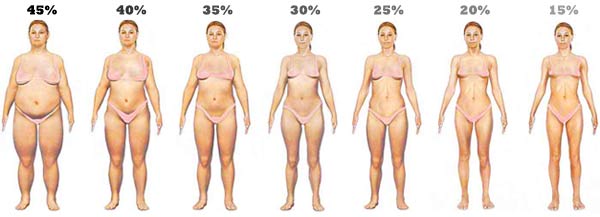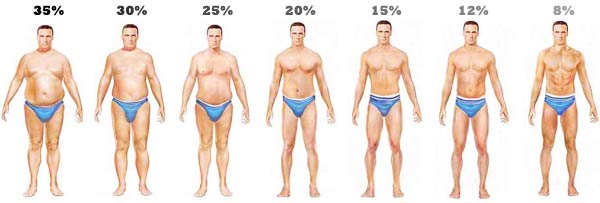Body fat percentage is a helpful way to track weight loss. Average body fat percentages vary between men and women, as well as between different age groups.
Below you’ll find a table with the different ranges of body fat for men and women, and illustrations of what these body fat percentages look like. Try to get you body fat percentage measured professionally, or use the body fat calculator for an estimate of your body fat percentage.
| Levels of Body Fat | Women | Men |
| Essential Fat | 10 – 13% | 2 – 5 % |
| Lean (Athlete) | 14 – 20% | 6 – 13% |
| Average (Fitness) | 21 – 24 % | 14 – 17% |
| Acceptable | 25 – 31% | 18 – 25% |
| Overweight | ≥32% | ≥26% |
A visual guide of the different body fat percentages looks like this.


Minimum Body Fat
It is impossible to decrease body fat levels to zero. Body fat can be divided into essential fat and storage fat.
Essential fat is needed for the body’s hormone and immune systems to function properly and is stored in the body’s major organs such as the heart, lungs, bone marrow and muscles. Physical and physiological health are adversely affected below the level of essential fat.
Women have a higher amount of essential fat as they carry additional essential gender-specific fat in the breasts, pelvis, hips and thighs. Essential fat accounts for at least 10% to 13% of a woman’s and 5% of a man’s total body weight.
Storage fat, on the other hand, is used as fuel for the body in times of need and is also required for good health. It is used to protect the internal organs in the chest and abdomen. The levels of this fat fluctuate, and is the weight that changes during weight gain and loss.
Essential fat and some storage fat is a required for normal body functioning. This is particularly true for women, in whom very low levels of body fat may cause a disruption/ loss of the menstrual (amenorrhea) cycle, this in turn resulting in an estrogen deficiency, infertility, hair loss, a decrease in bone density and premature osteoporosis.
Generally, women with body fat levels below 15-20 % may experience this disruption, as well as women (e.g. athletes) who train very heavily or reduce their calories significantly, even with a higher body fat percentage.
The point of amenorrhea is different for all women, for some it may be at 18%, for others it may be higher. It is important to understand that even with resumption of normal menses, some of the changes that have taken place may be irreversible, such as bone mineral loss (increasing risk of osteoporosis – brittle bones).
This is particularly true in adolescence, during which, 60 – 80% of skeletal bone is laid down and consolidated. Low estrogen levels during this time will cause inhibition of normal pubertal growth and development.
Amenorrhea is never healthy, desirable or acceptable. It is a sign that something is wrong. If you stop menstruating after a period of weight loss, it may be that you have gone too far. Try putting on a little weight to see whether this restores your menses and make an appointment with your general practitioner.
| Average Body Fat Percentage of Athletes | Women | Men |
| Triathlon | 10–15% | 5–12% |
| Swimmers | 10–16% | 6–12% |
| Marathon Runners | 10–16% | 5–10% |
| Olympic Gymnasts | 11–14% | 5–8% |
| Sprinters | 12–18% | 5–12% |
| Tennis Players | 14–20% | 10–16% |
| Volleyball | 16–25% | 11–14% |
Size vs Number of Fat Cells
Body fat is stored in fat cells and everyone is born with a specific number of fat cells. This number does not change. When we gain or lose weight, what does change is the size of these fat cells – they may grow bigger or shrink in size. However, there are exceptions to every rule and there are two instances during which there the number of fat cells can increase:
- During puberty when the number of fat cells increase.
- At greater than 60% body fat percentage , fat cells reach their limit in terms of size and more fat cells are produced.
When adults lose body fat there is a reduction in the size of the fat cells of the body, the only procedure that can reduce the number of fat cells is their surgical removal, i.e. liposuction. However, liposuction does not control the size of the fat cells left behind nor does it guarantee that growth/ re-growth of fat cells will not occur. Therefore, liposuction cannot guarantee the prevention of weight gain.


So what about people born with Lipoedema? Which is a chronic and incurable condition involving an abnormal build-up of adipose tissue. Doctors often get confused between Lipoedema and Lymphoedema, though in later stages Lipoedema can progress into what is known as Lipo-Lymphoedema. Lipoedema is often mistaken for obesity. People with this disease have normal levels of blood pressure and cholesterol etc. Normal diets don’t work as it is not a case of overeating. Do you think that liposuction can help?
Hi
I think it’s also important to note that ‘ideal’ body fat % vary (not largely) among different people. I like that you’ve shown this varient between average and athletes but something I rarely see being discussed is that the minimal amount of body fat for normal body function can be lower as long as calories/Nutrition/activity is calculated correctly.
Hi, I’ve been reading a few […several] of the articles on here, and the information really helps :), but I saw this one and was wondering if a person has muscle and fat, would their body fat percentages be different as compared to the images in the chart above?
Just wondering,
Thank you! 🙂
Hi VVN,
Everyone has both muscle and fat. The images in the chart above are just an approximation or an average. Body fat percentage literally means the percentage of your weight that is body fat. It is very possible for two people to weigh the same amount and still have different body fat percentages. For example, someone who is a 5’7 250-pound couch potato will most likely have a different body fat percentage than someone who is a 5’7 250-pound weight lifter.
I can give you my example – many years ago I reached the weight of 53kg (169cm) with no physical activity and this is when I lost my menstrual cycle. It was an indicator, that my fat level was too low.
Currently I weigh 61kg, I train around 12h a week, my fat level is 17% (measured with DEXA) and my menstrual cycle is going crazy! Although I am 8kg heavier, I risk, that I may lose my period again. So weight itself is not the best indicator for fat % (as also written above).